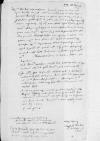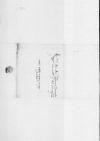List #2752
Sigmund von HERBERSTEIN do Ioannes DANTISCUSVienna, 1544-08-28
| odebrano Wormditt (Orneta), 1544-10-21 Rękopiśmienne podstawy źródłowe:
Pomocnicze podstawy źródłowe:
Publikacje:
| ||||||||||
Tekst + aparat krytyczny + komentarz Zwykły tekst Tekst + komentarz Tekst + aparat krytyczny
Reverendissimo domino, domino
Reverendissime Domine, domine observandissime, servitutem meam in primis Vestrae Reverendissimae Dominationi commendo.
Occurrit nuntius satis commodus ad dominum
Aiunt summum
Dat(ae) or Dat(um)⌈Dat(ae)Dat(ae) or Dat(um)⌉
Eiusdem Vestrae Reverendissimae Dominationis obsequentissimus
Postscript:
Locustarum ingentes copiae tarde quidem advenerunt, attamen milium et gramina omnia consumunt, oleribus et vitibus pepercerunt.
Naves vicecancellarius caesaris Sch scribit ex


 UUB, H. 154, f. 79v
UUB, H. 154, f. 79v